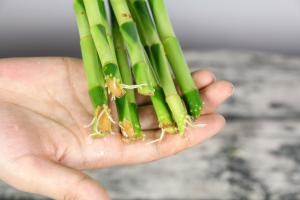How to Stake Large Tomato Plants
Staking tomato plants is an essential practice for any gardener looking to produce healthy and productive tomato plants. Staking is a method used to support tomato plants and is recommended for large tomato plants to help them retain their shape, prevent soil-borne diseases, and improve air circulation. Here are the steps on how to stake large tomato plants:
Step 1: Choose the Right Stake
Before anything else, choose the right stake to use for your tomato plants. Bamboo, metal or wooden stakes are commonly used. The stake should be at least three to five feet tall and sturdy enough to support the weight of the plant. It should also be impervious to moisture to prevent decay and rotting.
Step 2: Insert the Stake into the Ground
When selecting the site for staking, choose a spot with well-drained soil, and with enough space to grow a tall plant. Dig a hole about 8 inches deep into the ground and carefully insert the stake into the hole. Be sure to insert the stake about 6 inches away from the stem of the plant to provide enough room for growth.
Step 3: Tie the Plant to the Stake
After inserting the stake, tie the stem of the tomato plant to it using a soft or stretchy material such as twine or plastic tie. Tie loosely to avoid restricting the growth of the plant. Check the ties regularly throughout the growing season to avoid the ties cutting into the bark of the plant.
Step 4: Trim and Prune
Trimming and pruning the plant is essential in maintaining its shape and preventing overcrowding. Cut off any suckers that grow in the crotches of the stem and leaves below the first flower cluster. Suckers take up the energy that the plant would use to grow fruit, thus reducing the yield.
Step 5: Add Support as Needed
As the tomato plant continues to grow, add support as needed. This can be done by using more stakes or with cages. Cages are a great option to provide additional support and keep the plant off the ground. They are also reusable and can support multiple plants over several seasons.
Step 6: Maintain Consistent Watering and Fertilizing
Consistent watering and fertilizing are essential aspects of maintaining healthy tomato plants. Tomato plants require constant moisture for proper growth and development. Water the plant daily, especially during the hot summer months. Add fertilizer to the plant about once a week or as needed, depending on the type used.
Step 7: Harvesting and Cleaning up
Once the tomatoes begin to ripen, harvest them accordingly. Clean up the area around the plant to prevent any diseases or pests from lingering over to the next growing season. Cut down the plant and remove it from the ground before winter, to avoid any overwintering pests or diseases.
Staking large tomato plants is crucial in ensuring bountiful yields and healthy plants. Follow the steps above to successfully stake your large tomato plants and enjoy the fruits of your labor for the season!

 how many times do yo...
how many times do yo... how many planted tre...
how many planted tre... how many pine trees ...
how many pine trees ... how many pecan trees...
how many pecan trees... how many plants comp...
how many plants comp... how many plants can ...
how many plants can ... how many plants and ...
how many plants and ... how many pepper plan...
how many pepper plan...






























